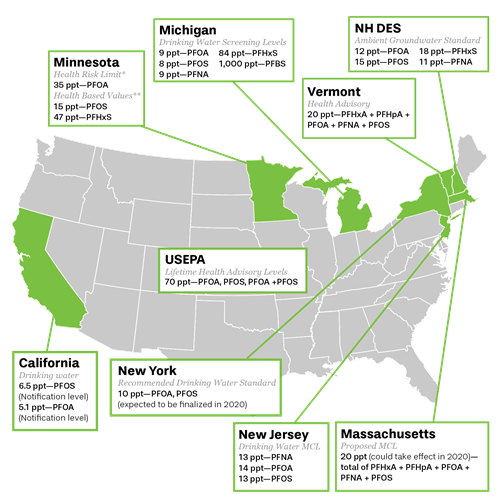PFAS Site Characterization

PFAS have been detected everywhere, from firefighting training sites to industrial manufacturing facilities, landfills and wastewater treatment plants (WWTPs). And ongoing research continues to explore the interactions between these chemicals and the environment, as well as with our own bodies. Promising treatment methods have been able to bring PFAS levels below federal and state regulatory thresholds, and some can even destroy the compounds entirely. But there is no one-size-fits-all treatment solution, and a better solution will rely on a better understanding of the characteristics of PFAS, their behaviors in the environment and their effectiveness protecting sensitive receptors.
Common Sources of PFAS Occurrence in the Environment
The Interstate Technology Regulatory Council (ITRC) identifies four major PFAS sources:
Fire training and response sites: Contamination originates from aqueous film-forming foams (AFFFs), a fire-extinguishing mixture used by the military, oil refineries, municipal airports and fire stations. AFFF contains highly diverse mixtures of PFAS.
Industrial sites: These include manufacturing facilities that synthesized products containing PFAS, as well as secondary manufacturing facilities, which use PFAS as a coating for finished products. Wind directions and atmospheric deposition play key roles in transporting PFAS from industrial manufacturing sites. PFAS can be detected in soil and water up- and down-gradient from the facility.
Landfills: Industrial waste and consumer goods treated with non-stick coatings can all terminate in landfills and ultimately groundwater. Unlined landfills are more likely to dispel PFAS into groundwater, which can happen steadily over decades. These are mostly shorter-chain PFAS, which differ from those found at industrial and fire training sites.
Wastewater treatment plants and biosolids: Possible reasons for PFAS occurring at WWTPs include PFAS concentrations in solid waste and the oxidation of PFAS precursors during the treatment process.
Analytical Tools for Site Characterization
A phased approach is typical for PFAS site characterization. Phase 1 may be to identify the presence of PFAS in suspected source area(s) at a site and their impact on drinking water sources. Phase 2 typically investigates point and non-point sources at a site and if these sources have migration pathways contributing to the drinking water sources. Phase 3 can involve further delineation of PFAS sources and their on-site and off-site extents. Phase 4 can be remedial investigation through collection of site-specific hydrogeological conditions, geochemical conditions, precursor transformation potential and remedial option evaluation.
Ongoing Research
Researchers continue to study PFAS mass storage, mass discharge, migration patterns and how they respond to environmental conditions and other co-contaminants. While analytical method detections continue to drop and state-level health advisory levels get more stringent (see Table 4 of ITRC PFAS fact sheet Regulations), the persistence and mobility of these contaminants pose significant challenges for site characterization. Other challenges include verifications of ambient PFAS levels and the presence of multiple point and non-point sources at a site. Techniques that can be used to differentiate PFAS sources are under early stage of development.
With in-house PFAS testing capabilities, CDM Smith is actively involved in developing PFAS property data, verifying PFAS transformation potential and working with academic partners to combine different PFAS analytical tools to further understand the roles of PFAA precursors in a conceptual site model. To continue this discussion, connect with one of our experts below.

Every site is comprised of different contaminants. We’re in a unique position to make sure a combination of technologies will fit exact site specifications.








